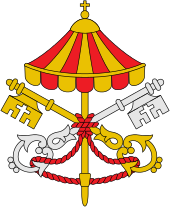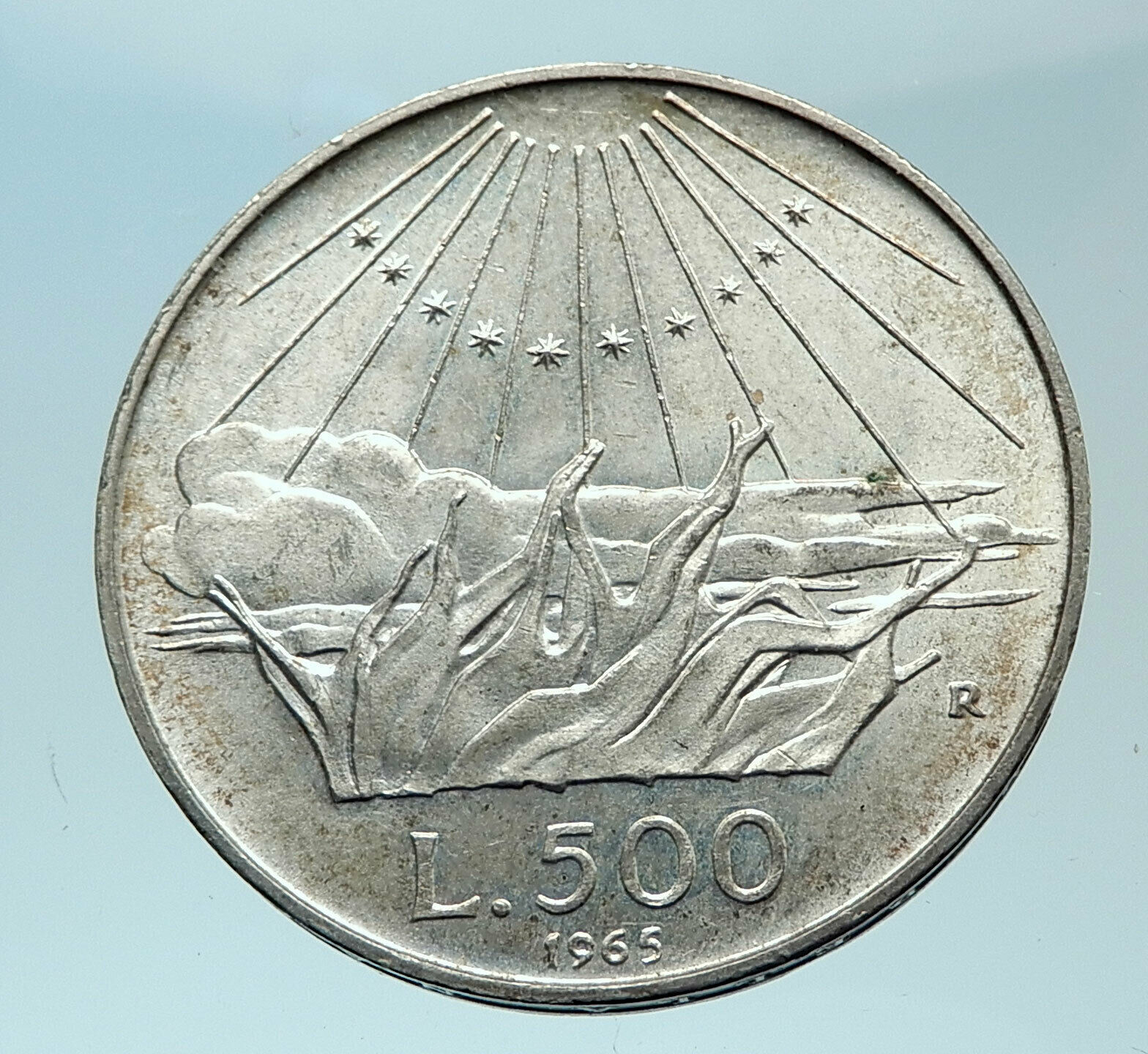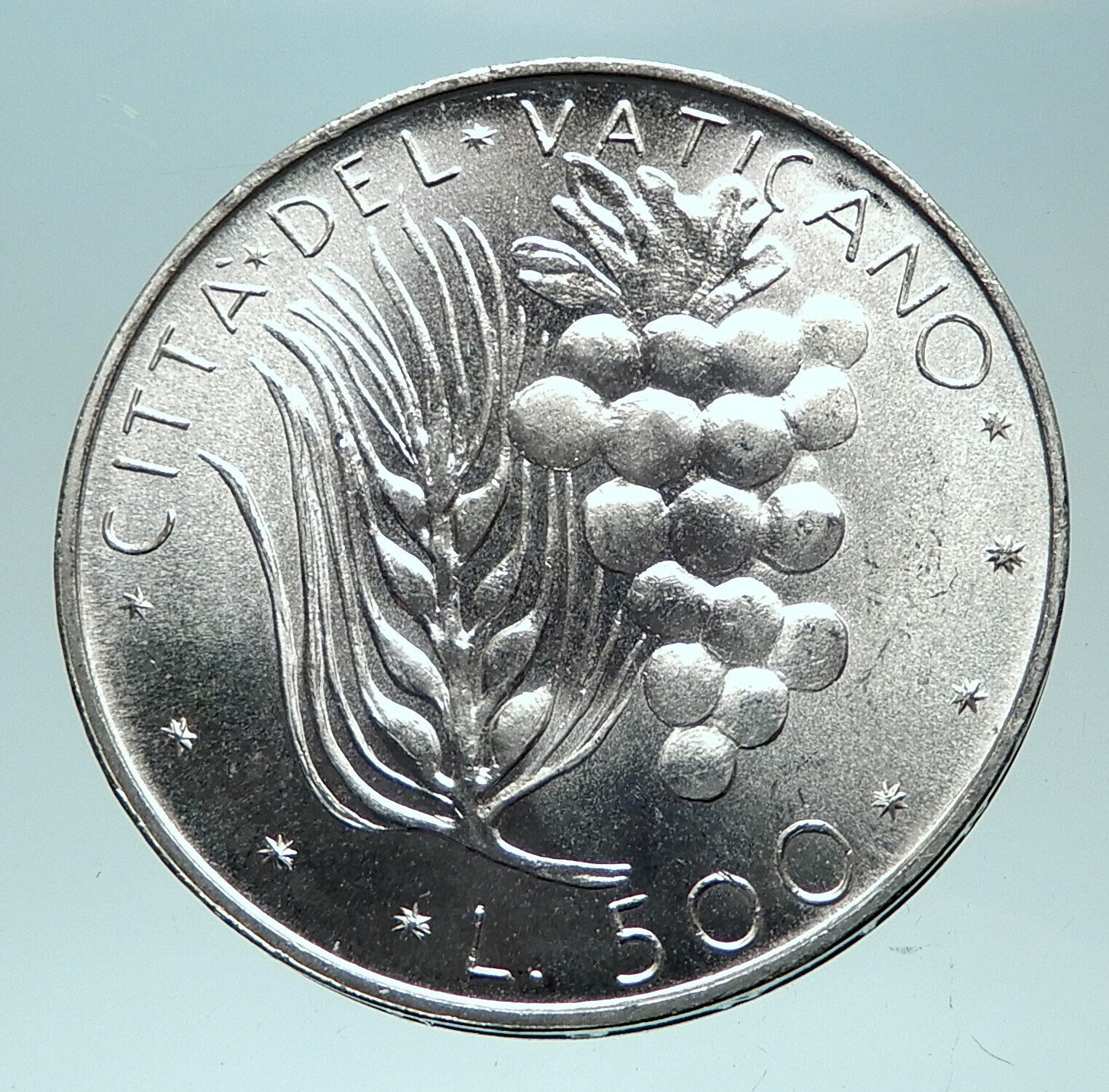|
Vatican City – Sede Vacante Commemorative issue for Cardinal Jean Villot
1978 Silver 500 Lire 29.3mm (10.99 grams) 0.835 Silver (0.2953 oz. ASW)
Reference: KM# 140 | Engraver: Tomas Gismondi
·SEDE·VACANTE·MCMLXXVIII·, Coat-of-Arms of Cardinal Jean Villot.
*VENI*SANCTE*SPIRITVS* STATO*DELLA*CITTA’, DEL* VATICANO *L.500*, Descending stylized dove.
Edge Lettering:
STATO DELLA CITTA DEL VATICANO
You are bidding on the exact item pictured, provided with a Certificate of Authenticity and Lifetime Guarantee of Authenticity.
Sede vacante in the canon law of the Catholic Church is the vacancy of the episcopal see of a particular church and especially that of the papacy. It is Latin for “the seat being vacant”, the seat in question being the bishop’s throne of the particular church.
After the death or resignation of a pope, the Holy See enters a period of sede vacante. In this case the particular church is the Diocese of Rome and the “vacant seat” is the cathedra of Saint John Lateran, the cathedral church of the Bishop of Rome. During this period, the Holy See is administered by a regency of the College of Cardinals.
According to Universi Dominici gregis, the government of the Holy See and the administration of the Catholic Church during sede vacante falls to the College of Cardinals, but in a very limited capacity. At the same time, all the heads of the departments of the Roman Curia “cease to exercise” their offices. The exceptions are the Cardinal Camerlengo, who is charged with managing the property of the Holy See, and the Major Penitentiary, who continues to exercise his normal role. If either has to do something which normally requires the assent of the Pope, he has to submit it to the College of Cardinals. Papal legates continue to exercise their diplomatic roles overseas, and both the Vicar General of Rome and the Vicar General for the Vatican City State continue to exercise their pastoral role during this period. The postal administration of the Vatican City State prepares and issues special postage stamps for use during this particular period, known as “sede vacante stamps”.
The coat of arms of the Holy See also changes during this period. The papal tiara over the keys is replaced with the umbraculum or ombrellino in Italian. This symbolizes both the lack of a Pope and the governance of the Camerlengo over the temporalities of the Holy See. As further indication, the Camerlengo ornaments his arms with this symbol during this period, which he subsequently removes once a pope is elected. Previously during this period the arms of the Camerlengo appeared on commemorative Vatican lira coinage. It now makes its appearance on Vatican euro coins, which are legal tender in all Eurozone states.

The umbraculum, the arms of the Holy See under sede vacante
The interregnum is usually highlighted by the funeral Mass of the deceased pope, the general congregations of the College of Cardinals for determining the particulars of the election, and finally culminates in the papal conclave to elect a successor. Once a new pope has been elected (and ordained bishop if necessary) the sede vacante period officially ends, even before the papal inauguration.
Cardinals present in Rome are required to wait at least fifteen days after the start of the vacancy before they hold the conclave to elect the new Pope. After twenty days have elapsed, they must hold the conclave, even if some cardinals are missing. The period from the death of the Pope to the start of the conclave was often shorter but, after Cardinal William Henry O’Connell had arrived just too late for two conclaves in a row, Pius XI extended the time limit. With the next conclave in 1939, cardinals began to travel by air. Days before his resignation in February 2013, Benedict XVI amended the rules to allow the cardinals to begin the conclave sooner, if all voting cardinals are present.[1] Historically, sede vacante periods have often been quite lengthy, lasting many months, or even years, due to lengthy deadlocked conclaves.
The most recent period of sede vacante of the Holy See began on 28 February 2013, after the resignation of Benedict XVI, and ended on 13 March 2013 with the election of Pope Francis, a period of 13 days.
The longest period without a Pope in the last 250 years was the approximately half year from the death in prison of Pius VI in 1799 and the election of Pius VII in Venice in 1800.
 Vatican City (/ˈvætɪkən/), officially Vatican City State (Italian: Stato della Città del Vaticano; Latin: Status Civitatis Vaticanae), is an independent city-state[9] enclaved within Rome, Italy. Established with the Lateran Treaty (1929), it is distinct from yet under “full ownership, exclusive dominion, and sovereign authority and jurisdiction” of the Holy See (Latin: Sancta Sedes). With an area of 44 hectares (110 acres), and a population of about 1,000, it is the smallest state in the world by both area and population. Vatican City (/ˈvætɪkən/), officially Vatican City State (Italian: Stato della Città del Vaticano; Latin: Status Civitatis Vaticanae), is an independent city-state[9] enclaved within Rome, Italy. Established with the Lateran Treaty (1929), it is distinct from yet under “full ownership, exclusive dominion, and sovereign authority and jurisdiction” of the Holy See (Latin: Sancta Sedes). With an area of 44 hectares (110 acres), and a population of about 1,000, it is the smallest state in the world by both area and population.
 The Vatican City is an ecclesiastical or sacerdotal-monarchical state (a type of theocracy) ruled by the pope who is, religiously speaking, the bishop of Rome and head of the Catholic Church. The highest state functionaries are all Catholic clergy of various national origins. Since the return of the popes from Avignon in 1377, they have generally resided at the Apostolic Palace within what is now Vatican City, although at times residing instead in the Quirinal Palace in Rome or elsewhere. The Vatican City is an ecclesiastical or sacerdotal-monarchical state (a type of theocracy) ruled by the pope who is, religiously speaking, the bishop of Rome and head of the Catholic Church. The highest state functionaries are all Catholic clergy of various national origins. Since the return of the popes from Avignon in 1377, they have generally resided at the Apostolic Palace within what is now Vatican City, although at times residing instead in the Quirinal Palace in Rome or elsewhere.
 The Holy See dates back to early Christianity, and is the primate episcopal see of the Catholic Church, with 1.3 billion Catholics around the world distributed in the Latin Church and 23 Eastern Catholic Churches. The independent Vatican City-state, on the other hand, came into existence in 11 February 1929 by the Lateran Treaty between the Holy See and Italy, which spoke of it as a new creation, not as a vestige of the much larger Papal States (756-1870), which had previously encompassed much of central Italy. The Holy See dates back to early Christianity, and is the primate episcopal see of the Catholic Church, with 1.3 billion Catholics around the world distributed in the Latin Church and 23 Eastern Catholic Churches. The independent Vatican City-state, on the other hand, came into existence in 11 February 1929 by the Lateran Treaty between the Holy See and Italy, which spoke of it as a new creation, not as a vestige of the much larger Papal States (756-1870), which had previously encompassed much of central Italy.
Within the Vatican City are religious and cultural sites such as St. Peter’s Basilica, the Sistine Chapel and the Vatican Museums. They feature some of the world’s most famous paintings and sculptures. The unique economy of Vatican City is supported financially by the sale of postage stamps and souvenirs, fees for admission to museums, and sales of publications.
|






 Vatican City (/ˈvætɪkən/), officially Vatican City State (Italian: Stato della Città del Vaticano; Latin: Status Civitatis Vaticanae), is an independent city-state[9] enclaved within Rome, Italy. Established with the Lateran Treaty (1929), it is distinct from yet under “full ownership, exclusive dominion, and sovereign authority and jurisdiction” of the Holy See (Latin: Sancta Sedes). With an area of 44 hectares (110 acres), and a population of about 1,000, it is the smallest state in the world by both area and population.
Vatican City (/ˈvætɪkən/), officially Vatican City State (Italian: Stato della Città del Vaticano; Latin: Status Civitatis Vaticanae), is an independent city-state[9] enclaved within Rome, Italy. Established with the Lateran Treaty (1929), it is distinct from yet under “full ownership, exclusive dominion, and sovereign authority and jurisdiction” of the Holy See (Latin: Sancta Sedes). With an area of 44 hectares (110 acres), and a population of about 1,000, it is the smallest state in the world by both area and population.  The Vatican City is an ecclesiastical or sacerdotal-monarchical state (a type of theocracy) ruled by the pope who is, religiously speaking, the bishop of Rome and head of the Catholic Church. The highest state functionaries are all Catholic clergy of various national origins. Since the return of the popes from Avignon in 1377, they have generally resided at the Apostolic Palace within what is now Vatican City, although at times residing instead in the Quirinal Palace in Rome or elsewhere.
The Vatican City is an ecclesiastical or sacerdotal-monarchical state (a type of theocracy) ruled by the pope who is, religiously speaking, the bishop of Rome and head of the Catholic Church. The highest state functionaries are all Catholic clergy of various national origins. Since the return of the popes from Avignon in 1377, they have generally resided at the Apostolic Palace within what is now Vatican City, although at times residing instead in the Quirinal Palace in Rome or elsewhere.  The Holy See dates back to early Christianity, and is the primate episcopal see of the Catholic Church, with 1.3 billion Catholics around the world distributed in the Latin Church and 23 Eastern Catholic Churches. The independent Vatican City-state, on the other hand, came into existence in 11 February 1929 by the Lateran Treaty between the Holy See and Italy, which spoke of it as a new creation, not as a vestige of the much larger Papal States (756-1870), which had previously encompassed much of central Italy.
The Holy See dates back to early Christianity, and is the primate episcopal see of the Catholic Church, with 1.3 billion Catholics around the world distributed in the Latin Church and 23 Eastern Catholic Churches. The independent Vatican City-state, on the other hand, came into existence in 11 February 1929 by the Lateran Treaty between the Holy See and Italy, which spoke of it as a new creation, not as a vestige of the much larger Papal States (756-1870), which had previously encompassed much of central Italy. 




